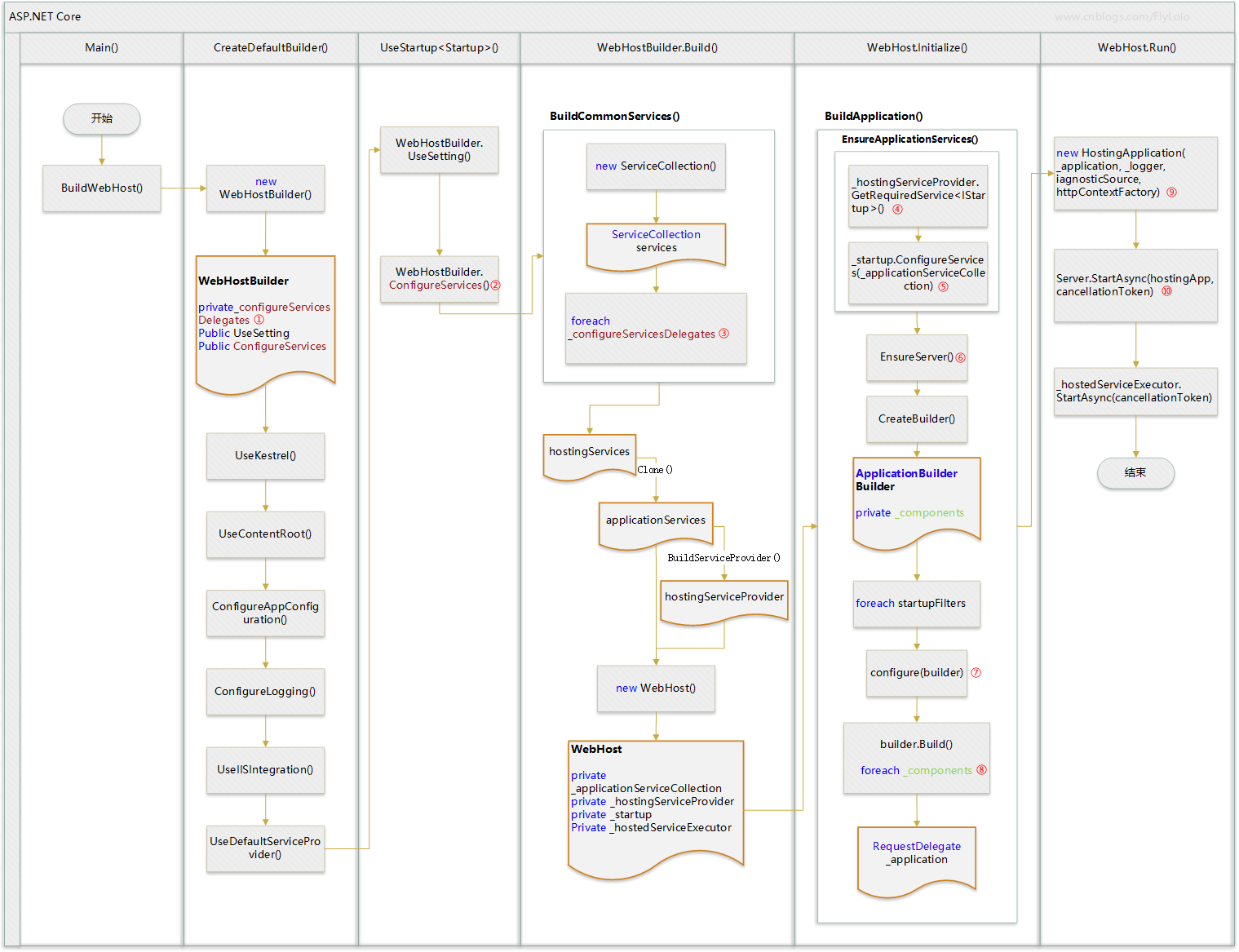为什么我们可以在Startup这个 “孤零零的” 类中配置依赖注入和管道?
它是什么时候被实例化并且调用的?
参数中的IServiceCollection services是怎么来的?
处理管道是怎么构建起来的?
启动过程中,系统“默默的”做了哪些准备工作?
上一篇文章讲了ASP.NET Core中的依赖注入(系列目录), 而它的配置是在Startup这个文件中的 ConfigureServices(IServiceCollection services) 方法,而且Startup这个类也没有继承任何类或者接口。 深入的想一想,可能会冒出类似上面列出的好多问题,下面用一幅图来看透它。
一、整体流程图
先上图, 觉得看不清可以点击看大图或者下载后放大查看。
图一(点击看大图)
二、WebHostBuilder
应用程序在Main方法之后通过调用CreateDefaultBuilder方法创建并配置WebHostBuilder,
1 public class WebHostBuilder : IWebHostBuilder
2 {
3 private readonly List<Action<WebHostBuilderContext, IServiceCollection>> _configureServicesDelegates;
4
5 private IConfiguration _config;
6 public IWebHostBuilder UseSetting(string key, string value)
7 {
8 _config[key] = value;
9 return this;
10 }
22 public IWebHostBuilder ConfigureServices(Action<WebHostBuilderContext, IServiceCollection> configureServices)
23 {
24 if (configureServices == null)
25 {
26 throw new ArgumentNullException(nameof(configureServices));
27 }
29 _configureServicesDelegates.Add(configureServices);
30 return this;
31 }
32 }
WebHostBuilder存在一个重要的集合① private readonly List<Action<WebHostBuilderContext, IServiceCollection>> _configureServicesDelegates; , 通过 ConfigureServices 方法将需要的Action加入进来。
UseSetting是一个用于设置Key-Value的方法, 一些常用的配置均会通过此方法写入_config中。
三、UseStartup<Startup>()
CreateDefaultBuilder之后调用UseStartup<Startup>(),指定Startup为启动类。
public static IWebHostBuilder UseStartup(this IWebHostBuilder hostBuilder, Type startupType)
{
var startupAssemblyName = startupType.GetTypeInfo().Assembly.GetName().Name;
return hostBuilder
.UseSetting(WebHostDefaults.ApplicationKey, startupAssemblyName)
.ConfigureServices(services =>
{
if (typeof(IStartup).GetTypeInfo().IsAssignableFrom(startupType.GetTypeInfo()))
{
services.AddSingleton(typeof(IStartup), startupType);
}
else
{
services.AddSingleton(typeof(IStartup), sp =>
{
var hostingEnvironment = sp.GetRequiredService<IHostingEnvironment>();
return new ConventionBasedStartup(StartupLoader.LoadMethods(sp, startupType, hostingEnvironment.EnvironmentName));
});
}
});
}
首先获取Startup类对应的AssemblyName, 调用UseSetting方法将其设置为WebHostDefaults.ApplicationKey(“applicationName”)的值。
然后调用WebHostBuilder的②ConfigureServices方法,将一个Action写入WebHostBuilder 的 configureServicesDelegates中。
这个Action的意思就是说,如果这个被指定的类startupType是一个实现了IStartup的类, 那么将其通过AddSingleton注册到services 这个ServiceCollection中, 如果不是, 那么将其“转换”成 ConventionBasedStartup 这个实现了 IStartup的类后再进行注册。这里涉及到一个StartupLoader的LoadMethods()方法,会通过字符串的方式查找“ConfigureServices”、“Configure{ environmentName}Services”这样的方法。
注意:这里只是将一个Action写入了configureServicesDelegates, 而不是已经执行了对IStartup的注册, 因为这个Action尚未执行,services也还不存在。就像菩萨对八戒说: 八戒(Startup)你先在高老庄等着吧, 将来有个和尚带领一个取经小分队(ServiceCollection services )过来的时候你加入他们。
其实在CreateDefaultBuilder方法中的几个UseXXX的方法也是这样通过ConfigureServices将对应的Action写入了configureServicesDelegates, 等待唐僧的到来。
四、WebHostBuilder.Build()
创建并配置好的WebHostBuilder开始通过Build方法创建WebHost了, 首先是BuildCommonServices,
1 private IServiceCollection BuildCommonServices(out AggregateException hostingStartupErrors)
2 {
3 //...省略...
4 var services = new ServiceCollection();
5 services.AddSingleton(_hostingEnvironment);
6 services.AddSingleton(_context);
7 //....各种Add....
9 foreach (var configureServices in _configureServicesDelegates)
10 {
11 configureServices(_context, services);
12 }
14 return services;
15 }
在这个方法里创建了ServiceCollection services(以唐僧为首的取经小分队), 然后通过各种Add方法注册了好多内容进去(收了悟空),然后③foreach 之前暂存在configureServicesDelegates中的各个Action,传入services逐一执行, 将之前需要注册的内容注册到services中, 这里就包括Startup(八戒),注意这里仅是进行了注册,而未执行Startup的方法。
处理好的这个services被BuildCommonServices返回后赋值给 hostingServices,然后 hostingServices经过Clone()生成 applicationServices,再由这个 applicationServices进行 GetProviderFromFactory(hostingServices)生成一个 IServiceProvider hostingServiceProvider.经过一系列的处理后,可以创建WebHost了。
var host = new WebHost(
applicationServices,
hostingServiceProvider,
_options,
_config,
hostingStartupErrors);
host.Initialize();
将生成的applicationServices 和 hostingServiceProvider作为参数传递给新生成的WebHost。接下来就是这个WebHost的 Initialize()。
五、WebHost.Initialize()
WebHost的 Initialize()的主要工作就是BuildApplication()。
EnsureApplicationServices(): 用来处理WebHost的 private IServiceProvider _applicationServices ,④Startup的ConfigureServices方法在这里被调用。
_startup = _hostingServiceProvider.GetRequiredService<IStartup>(); _applicationServices = _startup.ConfigureServices(_applicationServiceCollection);
通过 GetRequiredService<IStartup>() 获取到我们的_startup, 然后调用这个_startup的 ⑤ConfigureServices 方法,这就是我们用于依赖注入的startup类的ConfigureServices方法了。
所以,_applicationServices是根据_applicationServiceCollection 加上我们在_startup中注册的内容之后重新生成的 IServiceProvider。
EnsureServer()⑥:通过 GetRequiredService<IServer>()获取Server并配置监听地址。
var builderFactory = _applicationServices.GetRequiredService<IApplicationBuilderFactory>(); var builder = builderFactory.CreateBuilder(Server.Features); builder.ApplicationServices = _applicationServices;
获取到 IApplicationBuilderFactory并通过它⑦创建 IApplicationBuilder,并将上面创建的_applicationServices赋值给它的ApplicationServices,它还有个重要的集合_components
private readonly IList<Func<RequestDelegate, RequestDelegate>> _components = new List<Func<RequestDelegate, RequestDelegate>>();
从_components的类型可以看出它其实是中间件的集合,是该调用我们的_startup的Configure方法的时候了。
先获取定义的IStartupFilter, ⑧foreach这些IStartupFilter并与_startup的Configure方法一起将配置的中间件写入_components,然后通过 Build()创建RequestDelegate _application,
在Build()中对_components进行处理生成请求处理管道,关于IStartupFilter和生成管道这部分将在下篇文章进行详细说明。
六、WebHost.Run()
WebHost创建完毕, 最后一步就是Run起来了,WebHost的Run()会调用它的方法StartAsync()
public virtual async Task StartAsync(CancellationToken cancellationToken = default(CancellationToken))
{
//......var hostingApp = new HostingApplication(_application, _logger, diagnosticSource, httpContextFactory);
await Server.StartAsync(hostingApp, cancellationToken).ConfigureAwait(false);
_hostedServiceExecutor.StartAsync(cancellationToken).ConfigureAwait(false);
//.....
}
在之前的文章中我们知道,请求是经过 Server监听=>处理成httpContext=>Application处理,所以这里首先传入上面创建的_application和一个httpContextFactory来⑨生成一个HostingApplication,并将这个HostingApplication传入Server的StartAsync(), 当Server监听到请求之后, 后面的工作由HostingApplication来完成。
⑩hostedServiceExecutor.StartAsync()方法用来开启一个后台运行的服务,一些需要后台运行的操作比如定期刷新缓存等可以放到这里来。


